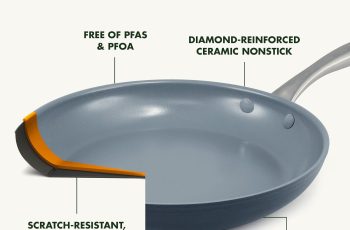Ad Blocker Detected
Our website is made possible by displaying online advertisements to our visitors. Please consider supporting us by disabling your ad blocker.
In the culinary world, achieving perfectly cooked meals is an art that demands meticulous attention to detail. Among the many essential kitchen tools, a saucepan holds a special place. With its versatile and compact design, it proves to be an indispensable asset for every home cook. However, achieving even cooking with a saucepan can sometimes pose a challenge. In this article, we will explore various techniques that will help you master the art of even cooking with a saucepan, ensuring that each dish you prepare is cooked to perfection. From heat control to proper stirring techniques, you will discover the secrets to achieving consistent results and delightful flavors in all your culinary endeavors.
Choosing the Right Saucepan
When it comes to cooking with a saucepan, one of the first things you need to consider is the size of the pan. Choosing the right size saucepan is crucial for even cooking. If the pan is too small, your ingredients may not cook evenly. On the other hand, if the pan is too big, you may end up with burnt or undercooked food. It’s important to select a saucepan that can comfortably hold the ingredients you’ll be cooking.
Another important factor to consider when choosing a saucepan is the material and construction of the pan. Look for a heavy-bottomed pan, as it provides even heat distribution and prevents hot spots. A heavy-bottomed pan will ensure that your food cooks evenly and prevents the risk of burning. In addition, a sturdy saucepan will last for a long time, making it a worthwhile investment for your kitchen.
Finally, an often overlooked feature of a saucepan is a lid. Opting for a saucepan with a lid is essential for certain cooking techniques. The lid helps to trap heat and moisture, which is especially important when simmering or braising. It also helps to speed up cooking times and ensures that your food will be evenly cooked. So, when choosing a saucepan, make sure to select one with a well-fitting lid.
Preheating the Saucepan
Preheating the saucepan is an important step to ensure even cooking. To preheat, place the saucepan on the stove and turn the heat to medium. Allow the pan to heat up for a few minutes before adding any ingredients. Preheating the pan helps to create a consistent cooking surface and ensures that your food will cook evenly.
By preheating the saucepan, you also reduce the risk of food sticking to the pan. When the pan is hot, it forms a non-stick surface, making it easier to cook delicate foods like fish or eggs. Preheating also allows the flavors of your ingredients to develop more fully, resulting in a more flavorful dish.
Using the Proper Cooking Heat
Once your saucepan is preheated, it’s important to adjust the heat according to the recipe you’re following. Different recipes call for different heat levels, so it’s crucial to follow the instructions closely. It’s also important to avoid using high heat for delicate sauces or ingredients that can easily burn.
For most recipes, maintaining a consistent medium-low heat is ideal for even cooking. This heat level allows your ingredients to slowly cook and develop flavors. It also gives you more control over the cooking process, making it easier to prevent burning or overcooking.
Remember to adjust the heat as needed throughout the cooking process. If you notice that the food is cooking too quickly or not cooking evenly, make adjustments to the heat level accordingly. This will help you achieve the desired results and ensure even cooking.
Stirring and Tossing Techniques
When cooking with a saucepan, using the proper stirring and tossing techniques is key to achieving even cooking. It’s recommended to use a wooden or heat-resistant spoon when stirring or tossing ingredients in a saucepan. These materials are less likely to scratch or damage the pan’s surface.
Stirring frequently is important to distribute heat evenly throughout the food. This prevents hot spots and helps to ensure that all ingredients are evenly cooked. It also helps to prevent sticking and burning, especially when cooking sauces or soups.
When tossing ingredients in a saucepan, be sure to do so gently to avoid splattering. This is especially important when working with liquids or sauces. Tossing gently will help to evenly distribute flavors and prevent any accidents or spills. So, be mindful of your technique when stirring or tossing in a saucepan to achieve the best cooking results.
Proper Ingredient Preparation
Properly preparing your ingredients is essential for achieving even cooking with a saucepan. One important step is to cut and chop ingredients uniformly. This ensures that all the pieces of food cook at the same rate and prevents uneven cooking. When the pieces are of different sizes, some may cook faster while others remain undercooked.
Another aspect of ingredient preparation is pre-cooking or softening ingredients as needed. Some ingredients may require pre-cooking to soften them before adding them to the saucepan. Others may need to be softened in the pan itself. Pre-cooking or softening ingredients helps to ensure that they cook evenly and become tender in the final dish.
When it comes to aromatics like onions or garlic, dicing or mincing them is important for even flavor distribution. Smaller pieces of aromatics release their flavors faster and more evenly, enhancing the overall taste of your dish. So, take the time to properly prepare your ingredients to achieve the best results when cooking with a saucepan.
Adding Ingredients at the Right Time
Knowing when to add ingredients is crucial for even cooking with a saucepan. Adding ingredients in a logical order ensures that each component has enough time to cook properly. This helps to prevent undercooked or overcooked ingredients in the final dish.
Start by sautéing aromatics such as onions, garlic, or spices. These ingredients release their flavors and aromas when heated, and adding them as the first step in cooking allows their flavors to develop fully. Sautéing aromatics also provides a solid flavor foundation for the rest of the ingredients.
After sautéing aromatics, it’s best to add ingredients with longer cooking times first. This ensures that they have enough time to cook thoroughly and become tender. Adding ingredients with shorter cooking times later prevents them from becoming overcooked or mushy.
Covering the Saucepan
Covering the saucepan during the cooking process is an effective technique for even cooking. When using a lid, steam is trapped inside the pan, helping to cook the food more evenly. The trapped steam creates a moist and controlled cooking environment that aids in the cooking process.
By covering the saucepan, you also reduce the need for excessive stirring, which can disrupt the cooking process and lead to uneven cooking. The lid helps to retain moisture and heat, ensuring that your food cooks evenly and stays tender.
However, it’s important to note that not all recipes require covering the saucepan. Some dishes benefit from evaporation and reduction of liquid, so be sure to follow the recipe instructions closely. Use a lid when appropriate to achieve even cooking, but also be mindful of when it may be best to leave the pan uncovered.
Maintaining Heat Distribution
Proper heat distribution is essential for even cooking with a saucepan. One common mistake is overcrowding the pan with too many ingredients. Overcrowding can lead to uneven cooking, as the ingredients may not have enough contact with the pan’s surface. It’s important to leave enough space between your ingredients to allow for proper heat distribution.
Ensuring that your ingredients make contact with the pan’s surface is also crucial for even cooking. This allows the food to cook properly and develop a desirable texture. Avoid piling ingredients on top of each other or letting them clump together in one area of the pan.
If you notice that heat distribution is uneven, you can adjust it by moving the pan around on the stove. This helps to distribute heat more evenly throughout the pan and prevents hot spots. Be cautious when moving a hot pan and use protective mitts or kitchen towels to avoid burns.
Using the Right Amount of Liquid
When cooking with a saucepan, using the right amount of liquid is crucial for achieving even cooking and the desired consistency of your dish. It’s important to follow recipe instructions for liquid measurements, as the amount of liquid can vary depending on the recipe.
Adding too much liquid can result in a watery or diluted dish, while too little liquid can lead to dry and undercooked ingredients. Adjusting the consistency of your dish is possible by adding or reducing liquid as needed. However, it’s advisable to make gradual adjustments to avoid drastic changes or alterations to the final dish.
When using high-starch thickening agents like cornstarch or flour, caution should be exercised. Adding too much can make the dish overly thick and affect the cooking process. It’s best to start with smaller amounts and gradually add more if needed, ensuring that the sauce remains smooth and evenly cooked.
Properly Monitoring and Testing
To ensure even cooking with a saucepan, proper monitoring and testing of your food are essential. Regularly check and adjust the heat as needed throughout the cooking process. This helps to maintain a consistent temperature and prevent uneven cooking or burning.
When it comes to testing for doneness, a fork or knife can be used. Insert the fork or knife into the thickest part of the food to check if it’s cooked through. If it goes through easily and the food is tender, it’s usually an indication that it’s done. However, it’s important to note that specific recipes may have different guidelines for doneness, so always refer to the recipe instructions.
For temperature-sensitive recipes, using a kitchen thermometer is highly recommended. This ensures that your food reaches the correct internal temperature, promoting even cooking and food safety. Whether it’s meat, poultry, or desserts, a kitchen thermometer is a valuable tool to ensure precise and even cooking.
In conclusion, achieving even cooking with a saucepan requires attention to detail and proper technique. From choosing the right saucepan and preheating it to using the proper cooking heat and stirring techniques, each step contributes to the overall evenness of your dish. By following these guidelines, you can confidently cook a wide range of recipes and enjoy consistently delicious results.

